
Carniola is a historical region that comprised parts of present-day Slovenia. Although as a whole it does not exist anymore, Slovenes living within the former borders of the region still tend to identify with its traditional parts Upper Carniola, Lower Carniola, and to a lesser degree with Inner Carniola. In 1991, 47% of the population of Slovenia lived within the borders of the former Duchy of Carniola.
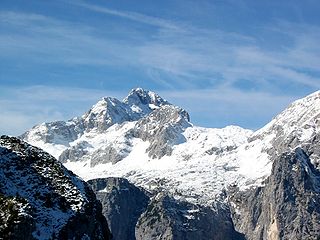
Triglav, with an elevation of 2,863.65 metres (9,395.2 ft), is the highest mountain in Slovenia and the highest peak of the Julian Alps. The mountain is the pre-eminent symbol of the Slovene nation, appearing on the coat of arms and flag of Slovenia. It is the centrepiece of Triglav National Park, Slovenia's only national park. Triglav was also the highest peak in Yugoslavia before Slovenia's independence in 1991.

The Duchy of Carinthia was a duchy located in southern Austria and parts of northern Slovenia. It was separated from the Duchy of Bavaria in 976, and was the first newly created Imperial State after the original German stem duchies.

Carinthia is the southernmost and least densely populated Austrian state, in the Eastern Alps, and is noted for its mountains and lakes. The main language is German. Its regional dialects belong to the Southern Bavarian group. Carinthian Slovene dialects, forms of a South Slavic language that predominated in the southeastern part of the region up to the first half of the 20th century, are now spoken by a small minority in the area.
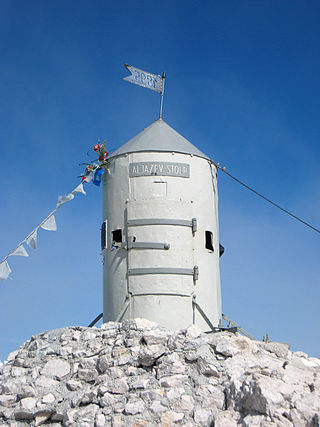
Aljaž Tower or the Triglav Tower is a tower, a storm shelter and a triangulation point on the summit of Mount Triglav in northwestern Slovenia. Along with Triglav, it is a landmark of Slovenia and a symbol of the Slovenehood. The tower was designed by Jakob Aljaž, a priest in the Upper Carniolan village of Dovje, who also had it erected, in 1895. Today it is owned by the state, tended by the Ljubljana Matica Alpine Club and stands on a parcel belonging to the Municipality of Bohinj.

Sigmund Zois Freiherr von Edelstein, usually referred as Sigmund Zois was a Carniolan nobleman, natural scientist and patron of the arts. He is considered one of the most influential figures of the Enlightenment Era in the Slovene Lands of Habsburg Austria.
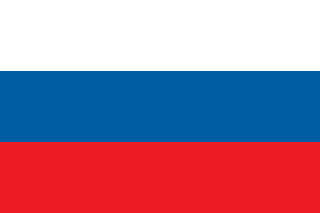
The Duchy of Carniola was an imperial estate of the Holy Roman Empire, established under Habsburg rule on the territory of the former East Frankish March of Carniola in 1364. A hereditary land of the Habsburg monarchy, it became a constituent land of the Austrian Empire in 1804 and part of the Kingdom of Illyria until 1849. A separate crown land from 1849, it was incorporated into the Cisleithanian territories of Austria-Hungary from 1867 until the state's dissolution in 1918. Its capital was German: Laibach, today Ljubljana.

The Eastern Alps are usually defined as the area east of a line from Lake Constance and the Alpine Rhine valley, up to the Splügen Pass at the Alpine divide, and down the Liro River to Lake Como in the south. The peaks and mountain passes are lower than the Western Alps, while the range itself is broader and less arched.
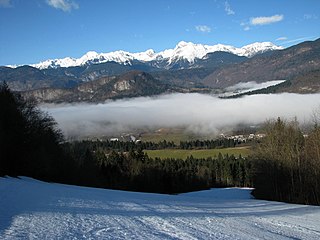
Bohinj, or the Bohinj Valley or Bohinj Basin, is a 20 km long and 5 km wide basin in the Julian Alps, in the Upper Carniola region of northwestern Slovenia. It is traversed by the Sava Bohinjka river. Its main feature is the periglacial Lake Bohinj. Bohinj is part of the Municipality of Bohinj, the seat of which is Bohinjska Bistrica.

Brazilian mythology is the subset of Brazilian folklore with cultural elements of diverse origin found in Brazil, comprising folk tales, traditions, characters and beliefs regarding places, people, and entities. The category was originally restricted to indigenous elements, but has been extended to include:
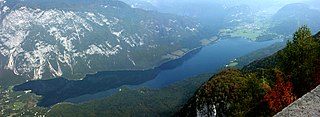
Lake Bohinj, covering 318 hectares, is the largest permanent lake in Slovenia. It is located within the Bohinj Valley of the Julian Alps, in the northwestern Upper Carniola region, and part of Triglav National Park.

The Windic March was a medieval frontier march of the Holy Roman Empire, roughly corresponding to the Lower Carniola region in present-day Slovenia. In Slovenian historiography, it is known as the Slovene March.
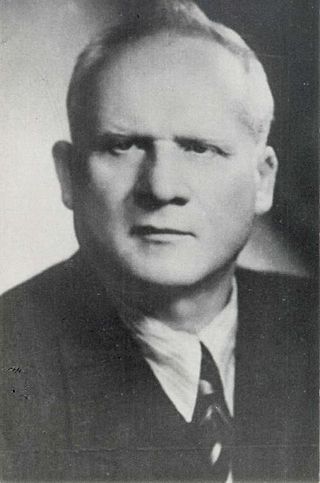
Prežihov Voranc was the pen name of Lovro Kuhar, a Slovene writer and communist political activist. Voranc's literary reputation was established during the 1930s with a series of Slovene novels and short stories in the social realist style, notable for their depictions of poverty in rural and industrial areas of Slovenia. His most important novels are Požganica (1939) and Doberdob (1940).
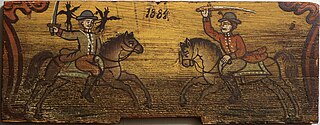
Kresnik is a Slavic god associated with fire, the summer solstice, and storms. His mythical home, a sacred mountain at the top of the world, represents the axis mundi.

Franjo Malgaj was a Slovenian soldier, military leader and poet. He was an officer of the Austro-Hungarian Army. After the dissolution of the Austro-Hungarian Empire after World War I, he became one of the commanding officers in the Slovene volunteer army under Rudolf Maister's command that fought against German Austrian units during the struggle for the northern Slovenian borderlands. He later became an officer in the Army of Kingdom of Serbs, Croats and Slovenes. He died during the Austrian-Yugoslav struggles in 1919. He is considered a Slovenian national hero.

Pavel Kunaver was a Slovene pedagogue, writer of popular science books, geography, history and Slovene language teacher and pioneer of amateur astronomy, mountain climbing, skiing and caving in Slovenia.

Angela Piskernik was an Austro-Yugoslav botanist and conservationist.

Aleš Kunaver was a Slovenian alpinist and tour guide.
Maria is the title given to a Filipino version of Cinderella collected by Fletcher Gardner and published in The Journal of American Folklore, in 1906. The story is related both to the international Cinderella narrative, as well as to the motif of the calumniated wife.
Joco Žnidaršič was a Slovenian photojournalist and editor.


















